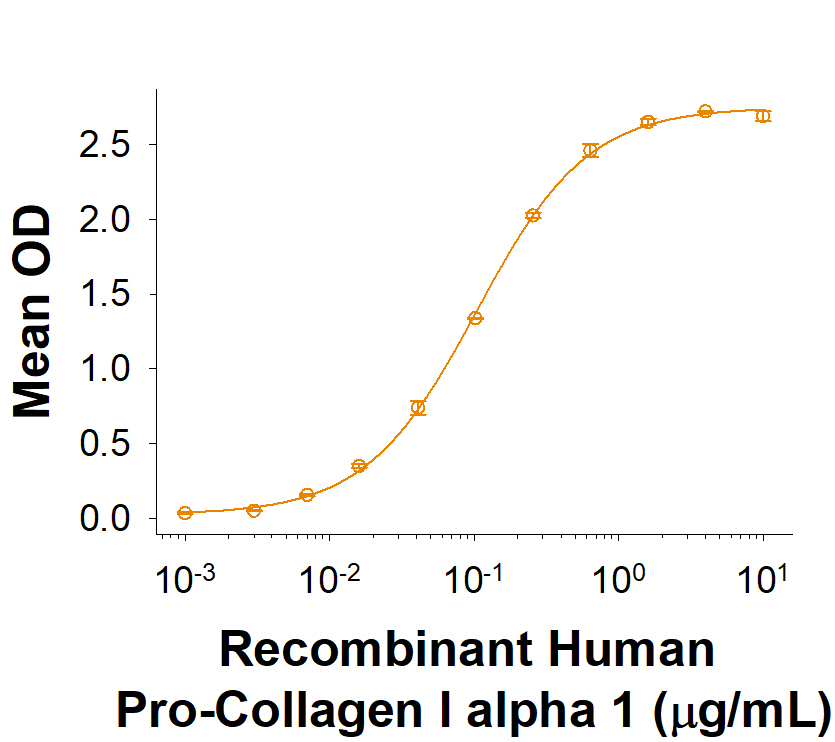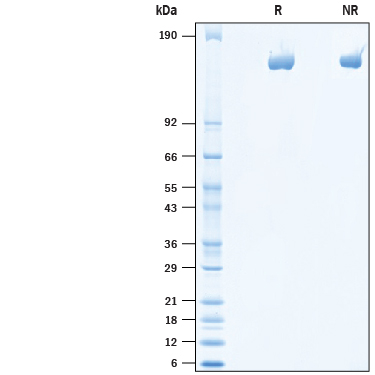Recombinant Mouse Mrc2 His-tag Protein, CF Summary
Product Specifications
Ala31-Ala1413, with a C-terminal 6-His tag
Analysis
Product Datasheets
Carrier Free
CF stands for Carrier Free (CF). We typically add Bovine Serum Albumin (BSA) as a carrier protein to our recombinant proteins. Adding a carrier protein enhances protein stability, increases shelf-life, and allows the recombinant protein to be stored at a more dilute concentration. The carrier free version does not contain BSA.
In general, we advise purchasing the recombinant protein with BSA for use in cell or tissue culture, or as an ELISA standard. In contrast, the carrier free protein is recommended for applications, in which the presence of BSA could interfere.
10491-EN
| Formulation | Lyophilized from a 0.2 μm filtered solution in PBS. |
| Reconstitution | Reconstitute at 500 μg/mL in PBS. |
| Shipping | The product is shipped at ambient temperature. Upon receipt, store it immediately at the temperature recommended below. |
| Stability & Storage: | Use a manual defrost freezer and avoid repeated freeze-thaw cycles.
|
Scientific Data
 View Larger
View Larger
 View Larger
View Larger
2 μg/lane of Recombinant Mouse Mrc2 His-tag (10491-EN) was resolved with SDS-PAGE under reducing (R) and non-reducing (NR) conditions and visualized by Coomassie® blue staining, showing bands at 145-165 kDa.
Reconstitution Calculator
Background: Mrc2
Mrc2 (C-type Mannose Receptor 2), also known as MMR2, Endocytic Receptor 180 and uPARAP, is a 180‑kDa type I transmembrane protein. It is one of the mannose receptor (MR) family members which share a common domain organization and have a broad range of biological functions (1). Mrc2 is an endocytic receptor that is found on migrating cells, including cancer cells, macrophages, fibroblasts and endothelial cells (2). Mature mouse Mrc2 is composed of 1449 amino acid (aa) that includes a 1383 aa extracellular domain (ECD), a 21 aa transmembrane region, and a 45 aa cytoplasmic domain. The ECD shows one ricin B‑type lectin domain, one fibronectin type II domain and eight C‑type lectin domains. Within the ECD, mouse Mrc2 shares 91% and 97% aa identity with human and rat Mrc2, respectively. Mrc2 plays an important role in extracellular matrix remodeling through interaction with its ligands, including Man, Fuc, NAcGlc, collagens and urokinase plasminogen activator receptor (uPAR) (1-3). This cell surface molecule has been reported to promote cell invasion through matrix remodeling by internalizing large fragments of collagen and routing it to the lysosome for intracellular degradation and cell chemotaxis (2). It has also been reported to interact with matrix metalloprotease-13 (MMP-13) and collagen V on the cell surface (4).
- Yuan, C. et al. (2016) Biochem. J. 473:2359.
- Durrel, T. et al. (2018) Nat. Commun. 9:5178.
- Behrendt, N. et al. (2000) J. Biol. Chem. 275:1993.
- Englehom, L.H. et al. (2001) Lab. Invest.. 81:1403.
FAQs
No product specific FAQs exist for this product, however you may
View all Proteins and Enzyme FAQsReviews for Recombinant Mouse Mrc2 His-tag Protein, CF
There are currently no reviews for this product. Be the first to review Recombinant Mouse Mrc2 His-tag Protein, CF and earn rewards!
Have you used Recombinant Mouse Mrc2 His-tag Protein, CF?
Submit a review and receive an Amazon gift card.
$25/€18/£15/$25CAN/¥75 Yuan/¥1250 Yen for a review with an image
$10/€7/£6/$10 CAD/¥70 Yuan/¥1110 Yen for a review without an image
